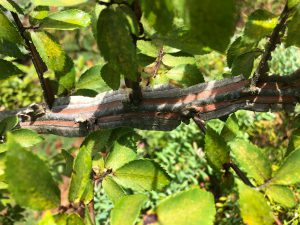
Until Hurricane Ivan, I’d never heard of a winged elm (Ulmus alata). While present in the wild, it is not a super common landscape tree. Plus, with Dutch elm disease still out there, I really haven’t seen a lot of elms around the south. After the insanely busy hurricane seasons of 2004-2005, though, a team of UF IFAS researchers took to the recently-cleared roads and started conducting tree surveys all around the state. They wanted to understand how trees fared during the winds of Charley, Frances, Ivan, Jeanne, Dennis, Katrina, and Rita—which tree species still stood, and which ones caused the most widespread damage when toppled over. That study is a wealth of information worth several more articles, but you can read their thorough (and useful) results here.
One of the trees to come out towards the top of the “wind-resistant” list for north Florida was the winged elm. It has small serrated leaves and grows to an average height of 30-40 feet. It grows best in full/partial sun and can thrive in a wide variety of soils. But the most interesting feature, to me, are its branches. Each branch is lined with flat, cork-like projections, giving it the “wing” in its name. The wings harden off in larger, older sections of the tree but are spongy and flexible on younger branches, especially as you move towards the growing tip. The “wings” are a bit of a mysterious adaptation. Several other plants native to our area, such as sweetgum trees and winged sumac, have wing features, too. Some botanists have theorized the wings may protect the bark in fire-prone areas, while others muse it could help prevent younger plants from being eaten by deer. So far, I have yet to find research showing anything conclusively.

Like other elms, it has a lovely yellow fall color, which can be hard to find in northwest Florida. It is also a larval host plant for the question mark butterfly (Polygonia interrogationis). If you’ve never seen a winged elm, we have a lovely example planted near the front of the Escambia Extension demonstration gardens–come visit sometime! I like it so much that I planted one in my front yard, too.
Fun fact, especially for fishing or Pensacola baseball aficionados—the winged elm is also known as a “wahoo” elm—a name given to it by the Creek Indians.
 1
1
